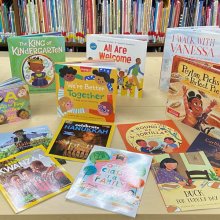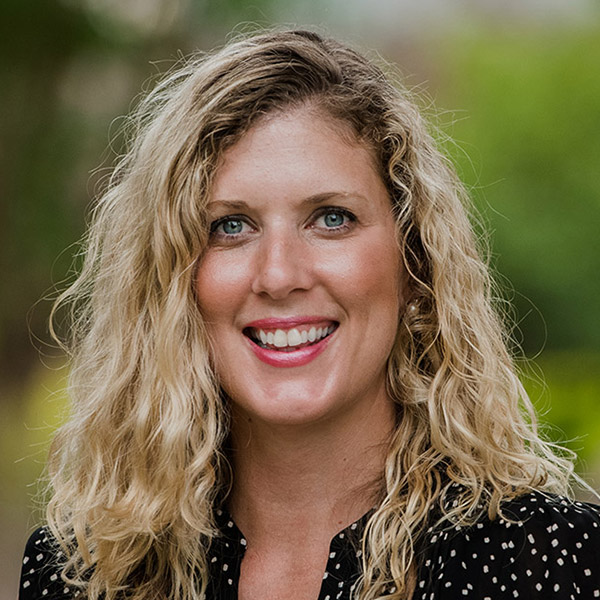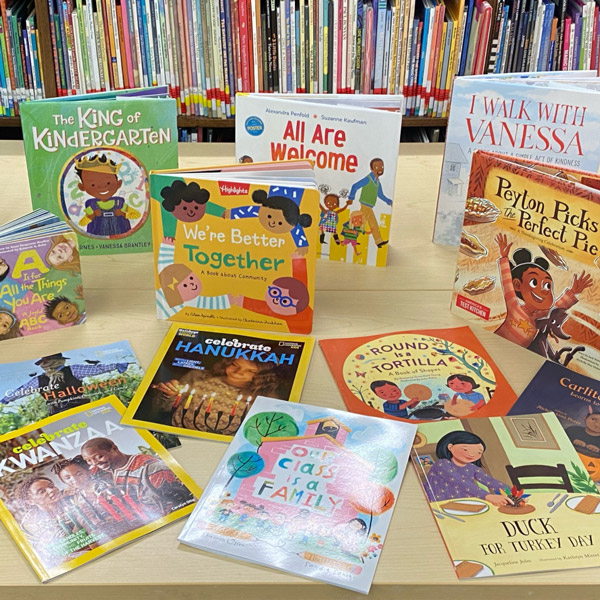Building Community Through Children's Literature

“Pencils sharpened in their case. Bells are ringing, let’s make haste. School’s beginning, dreams to chase. All are welcome here.”
All Are Welcome Here by Alexandra Penfold and Suzanne Kaufman
Lower School teachers have a few more tools in their pencil boxes after the Westchester faculty took a deep dive into evaluating our programming and how it develops a community where everyone belongs. By listening, learning and acting, faculty have sharpened the lens on how their classrooms, teaching and curriculum materials can be more culturally relevant and inclusive.
One step taken in the Lower School is analyzing the books read in classrooms. Upon doing so, we discovered that more could be done to enhance the representation of diversity in the classroom libraries and novel studies. This discovery led to a shared commitment in using Lower School budget dollars to purchase diverse children’s literature for classrooms. There are so many benefits to having access to a wide variety of books, but more importantly, literature can be used purposefully to help build community and a sense of belonging.

Keep reading for some examples, including titles that have been added to classroom libraries. Titles with an asterisk* are available at the WCDS Book Fair through Wednesday.
Knowing Yourself - Celebrating Who You Are
One interesting comparison is to think about books as mirrors. Seeing yourself, or someone like you, represented in literature is important in building cultural empowerment, which is where you are proud of your own culture and identity. Students need to find relatability in literature and see representation of themselves in what they read. When children recognize themselves in books, it helps students make meaningful connections to literature and makes them feel seen and heard.
Books like Sulwe by Lupita N’yongo, The Proudest Blue by Ibtihaj Muhammad, Crossover* and Rebound by Kwame Alexander, and Hair Love by Matthew H. Cherry, are books purchased that share a message of family and cultural pride along with body positivity. Reading aloud a book like Alma and How She Got Her Name by Juana Martinez-Neal and taking time to share stories about what makes your name special is a great way to give students an opportunity to take pride in one part of their unique identity -- their names.
Knowing Others - Building Empathy and Understanding
In addition to mirrors, books should also be windows for children, where they open eyes to differences in the world around them. Books that show cultural, geographical, ethnic, racial, socio-economic and family differences, just to name a few, allow children to build a greater understanding for people who may be different from themselves. Combining cultural empowerment (knowing self) with cross-cultural empathy (knowing others) are excellent ways to build community and a sense of belonging.
Books like Same, Same But Different by Jenny Sue Kostecki-Shaw, The Colors of Usby Karen Katz, Blended* by Sharon M. Draper, and Save Me a Seat by Sarah Weeks and Gita Varadarajan are excellent books that build greater empathy and understanding for differences. The picture book Families, Families, Families by Suzanne Long can be used as a starting point to share how families can be similar and different. Then, classes can create student-made books where each student has a page that highlights their unique family, and this can provide an opportunity for students to begin recognizing similarities and appreciating differences as they read it over and over.
Grow Your World - Make a Difference
Once children develop a better sense of self and build a deeper understanding of others, they are more capable of thinking of outward ways to make our world a better place. Whether that is thinking about ways to be a good friend to all, finding ways to go out of their way to show kindness to everyone, or giving children the confidence that they can do anything they put their minds to accomplishing, these are ways children can grow their world.
For example, teachers might read a book like Say Something by Peter Reynolds and give children a voice to share their hopes and dreams in a speech bubble activity. Books like Strictly No Elephants by Lisa Mantchev, I Walk with Vanessa* by Kerascoët, The Smallest Girl in the Smallest Grade by Justin Roberts, and Amina’s Voice by Hena Khan can also give children positive encouragement to go out and make a difference!
In all, a little over $1,000 was spent on books that diversify classroom libraries. Teachers are using these books as read-alouds and in-classroom lessons. Students can also check these titles out of classroom libraries to read in class or take home to enjoy. Take a look at this slideshow that highlights the books that have been added in each grade level. In addition, Lower School teachers were very intentional about updating their summer reading lists to offer additional choices that were both mirrors and windows for students.
These are just small steps in a continued journey to learn and grow. My hope is that we will continue to sharpen our diversity, inclusion and belonging lens, and we plan to stay committed to finding additional ways to build community. Just like in the message from Christian Robinson’s book You Matter, ultimately, our goal at Westchester is that everyone knows how important they are, sees how differences bring value to our community and beyond, and that each Wildcat and their family feels genuinely connected to each other in our community throughout their child’s educational journey at WCDS.
If you have any specific questions about diversity, inclusion and belonging at WCDS, feel free to explore more resources on our website or set a time to talk to your child’s division head or Head of School Cobb Atkinson.
 By Blair Hawley
By Blair Hawley
Head of Lower School

















